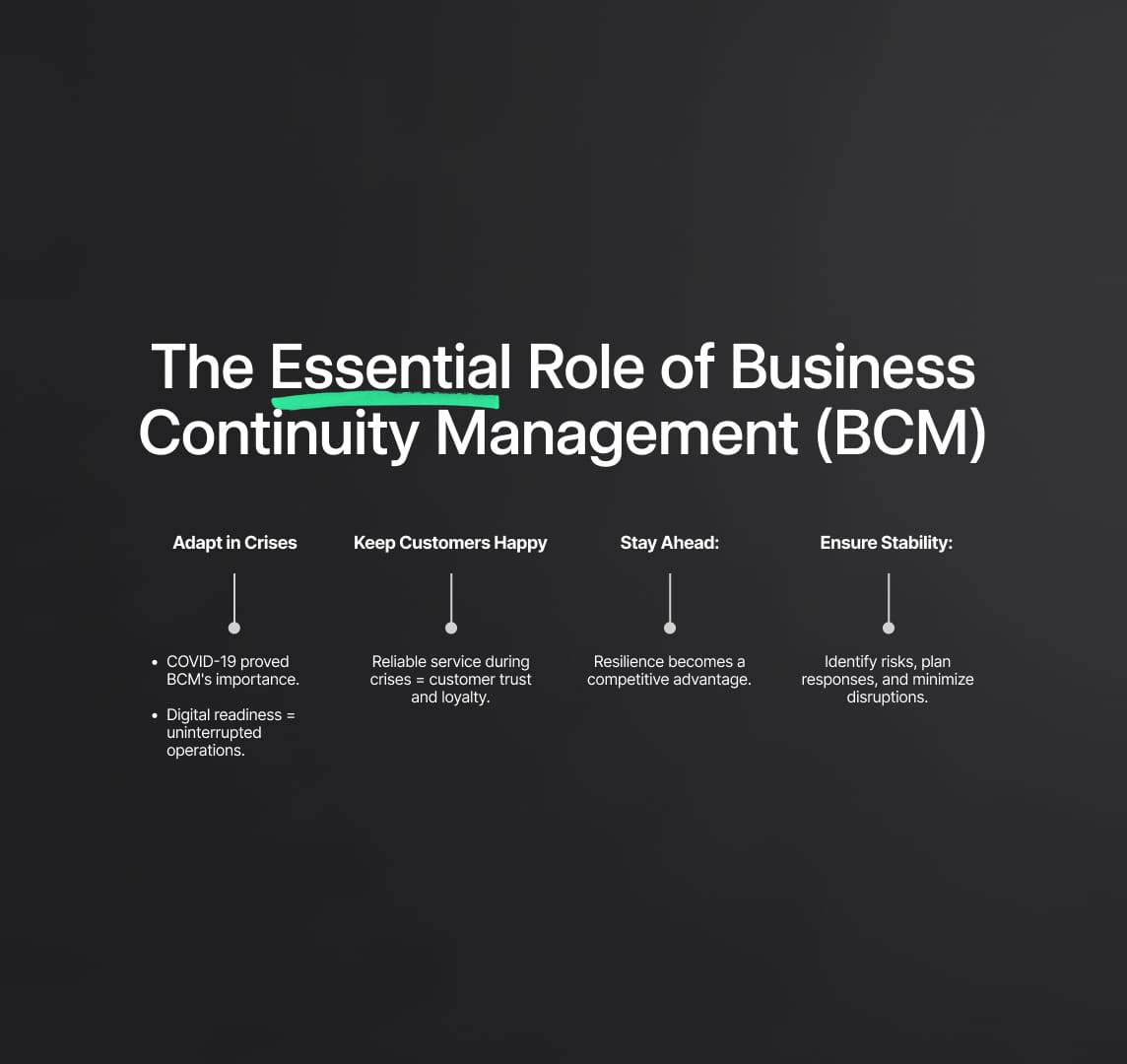Business Continuity Management in Compliance
Business Continuity Management (BCM) in 2023 integrates Governance, Risk, and Compliance (GRC) for enhanced resilience. The approach combines strategic governance, proactive risk management, and compliance in BCM to adapt to business challenges and disruptions.

Grand “Answer”:
Business Continuity Management (BCM) is an essential aspect of compliance as it helps ensure that businesses can continue to operate during a disaster or unforeseen event. This involves having a detailed plan in place to manage incidents and recover from them swiftly [1]. It's a valuable asset that requires a deep understanding of modern standards and changes, including potential risks and their impact on the business [2]. BCM compliance not only reduces operational risks but also ensures the organization meets the regulatory standards set by financial and governance institutions [2]. Therefore, it is crucial for businesses to stay updated with the latest BCM compliance standards and regulations to maintain operational efficiency [1][2].
Source
[1]

[2]

In an era defined by unprecedented global challenges, the significance of Business Continuity Management (BCM) has reached new heights. As we navigate through 2023, facing pandemics, economic upheavals, and escalating cyber threats, the resilience and continuity of businesses become more crucial than ever. This strategic guide is meticulously crafted to offer an in-depth exploration of BCM, presenting it as a lifeline in today's rapidly evolving business landscape.
- Proactive Strategy for Uncertain Times:
- BCM has evolved into a proactive strategy crucial for safeguarding seamless business operations.
- More than a reactive measure, it's an essential toolkit for businesses striving to thrive amidst uncertainties.
- Demystifying BCM Complexities:
- The guide aims to demystify the complexities of BCM, providing a clear, actionable roadmap for companies.
- Illuminates the pivotal role of BCM in ensuring operational resilience, empowering businesses to navigate disruptions with agility.
- Crucial Role in Operational Resilience:
- The crux of BCM lies in preparing for the unexpected, ensuring the maintenance of critical functions and swift recovery from disruptions.
- Emphasizes that a robust BCM plan supports sustainable growth and stability amid adversities.
- Strategic Importance in Modern Business Governance:
- The guide highlights the strategic importance of BCM as an indispensable component of modern business governance.
- Goes beyond risk mitigation, presenting BCM as a foundation for resilience, growth, and stability.
- Equipping Businesses for Success:
- Aims to equip businesses with the knowledge and tools to develop and implement effective BCM strategies.
- Provides insights to tailor BCM strategies to unique business needs.
- Journey into Business Continuity:
- Invites readers to join the exploration of BCM, understanding and mastering one of the most critical aspects of modern business strategy.
- A comprehensive guide for businesses navigating the evolving landscape of uncertainties.
The Essential Role of Business Continuity Management (BCM)
In the contemporary business landscape, marked by unprecedented challenges and uncertainties, the role of Business Continuity Management (BCM) has transitioned from a strategic advantage to an indispensable necessity. The evolving global context, characterised by rapid technological advancements, environmental threats, and geopolitical tensions, has amplified the need for robust BCM strategies.
Resilience During Global Crises: Learning from the COVID-19 Pandemic
A prime example of BCM's critical role is seen in how organizations navigated the COVID-19 pandemic. Companies that had preemptive BCM plans in place were better equipped to adapt to the sudden shift in operational dynamics. For instance, businesses that had previously invested in digital infrastructure and remote working capabilities were able to maintain continuity in their operations, despite the lockdowns and social distancing measures. This not only ensured uninterrupted service delivery but also protected them from significant financial losses.
Maintaining Customer Trust and Loyalty
In times of crisis, customer expectations around service availability and reliability heighten. Firms with effective BCM strategies were able to uphold their service commitments, thereby maintaining and even enhancing customer trust. For example, financial institutions that offered seamless online banking services during the pandemic retained customer loyalty, while those that faltered faced customer dissatisfaction and attrition.
Gaining a Competitive Advantage
BCM also serves as a strategic differentiator in competitive markets. Businesses that demonstrate resilience in the face of disruptions are more likely to attract and retain clients and partners. This resilience, underpinned by effective BCM, becomes a unique selling proposition, showcasing reliability and long-term viability.
Ensuring Business Stability and Continuity
The multifaceted benefits of BCM extend beyond crisis management to ensuring overall business stability and continuity. It involves identifying potential risks, assessing their impact on critical business functions, and developing response strategies. This proactive approach allows to minimize the impact of disruptions, ensuring the stability of their operations. For example, companies that have robust supply chain continuity plans can quickly adapt to supplier disruptions, maintaining their production and distribution timelines.

Leadership in Business Continuity Management (BCM) Implementation
Engaging Senior Management: The Catalysts of BCM
The role of senior leadership in the successful implementation of Business Continuity Management (BCM) cannot be overstated. Leaders are not just decision-makers; they are the driving force that propels BCM from a concept to a practical, living aspect of the firm. This section delves into the multifaceted role of leadership in the realm of BCM.
Championing BCM Initiatives:
- Vision and Direction: Leadership sets the tone for BCM. By clearly articulating the vision and strategic importance of BCM, leaders can align it with the overall objectives. This vision becomes the guiding light for all BCM activities.
- Resource Allocation: Leaders control the purse strings. They have the power to allocate the necessary resources – be it financial, human, or technological – to develop and maintain effective BCM strategies.
Influencing Culture:
- Creating BCM Awareness: Leaders can spearhead initiatives to raise awareness about the importance of BCM throughout the company. Through regular communication and engagement, they can foster a culture that values preparedness and resilience.
- Leading by Example: When leaders actively participate in BCM training and drills, they send a powerful message about its importance. Their involvement encourages a similar commitment across all levels of the firm.
Integrating BCM with Strategic Goals:
- Alignment with Business Objectives: Effective leaders integrate BCM strategies with the organization’s broader goals. This integration ensures that BCM is not an isolated function but a core aspect of the business planning process.
- Flexibility and Adaptability: In today’s dynamic business environment, leaders must be adept at adapting BCM strategies in response to changing circumstances. This adaptability ensures that BCM plans remain relevant and effective.
Ensuring Compliance and Continuous Improvement:
- Policy and Governance: Leaders are responsible for establishing and enforcing policies that govern BCM practices. This governance role is crucial for ensuring compliance with legal and regulatory requirements.
- Review and Enhancement: Leadership involvement is vital in the regular review and updating of BCM plans. By prioritizing continuous improvement, leaders can ensure that BCM strategies evolve in tandem with the changing risk landscape.
Practical Steps for Leadership Involvement in BCM:
- Regular BCM Briefings: Leaders should receive frequent updates on BCM initiatives, including any changes in risk assessments, updates to continuity plans, and outcomes of drills and simulations.
- Active Participation in Drills: Senior management should actively participate in BCM drills and simulations. This not only reinforces their commitment but also provides them with firsthand experience of the challenges and potential gaps in BCM plans.
- Stakeholder Engagement: Leaders must engage with various stakeholders, including employees, customers, and partners, to communicate the importance of BCM and its role in the organization's long-term stability.

Tailoring Business Continuity Management (BCM) to Specific Business Needs
"In this critical section, we delve into the art of customizing Business Continuity Management (BCM) strategies to fit the unique needs of individual businesses. Every institution is distinct in its operations, risks, and challenges, making a one-size-fits-all approach to BCM impractical. This section is designed to guide businesses through the intricate process of tailoring their BCM strategies, ensuring they are as effective and relevant as possible.
Understanding Your Business's Unique Landscape:
The first step in customisation is a thorough understanding of your business's unique operational characteristics. This involves an in-depth analysis of your business model, key processes, and critical functions. Recognizing these elements helps in identifying which areas of your business are most vulnerable and which require prioritized attention in your BCM plan
Conducting Comprehensive Risk Assessments:
Risk assessment forms the backbone of any BCM strategy. In this phase, businesses need to assess potential threats specific to their industry, location, and operational structure. The assessment should consider a wide range of factors, including natural disasters, technological failures, supply chain disruptions, and cybersecurity threats. A detailed risk assessment not only identifies potential hazards but also evaluates their likely impact and frequency, enabling businesses to prioritize their response strategies accordingly.
Engaging Stakeholders in the BCM Process:
An effective BCM strategy requires input and collaboration from various stakeholders. This includes employees at all levels, management, suppliers, and even customers. Engaging these stakeholders in the BCM process ensures a more comprehensive understanding of potential risks and their impacts. It also fosters a culture of preparedness and resilience within the firm.
Developing BCM Plans:
Armed with a detailed risk assessment and stakeholder input, businesses can now develop a BCM plan that addresses their specific needs. This plan should outline clear procedures for response and recovery for different types of disruptions. It's crucial to ensure that the plan is practical, achievable, and aligns with the overall strategic objectives of the organization.
Real-Life Examples of Successful BCM Implementation:
To provide practical insights, we will explore real-life case studies of businesses that have successfully implemented BCM strategies. These examples will highlight how they have navigated unique challenges and adapted their BCM plans to their specific operational landscapes. Through these case studies, businesses can learn valuable lessons and best practices in BCM customization.
Business Continuity Management (BCM) Through Best Practices and International Standards
In the complex and ever-changing world of business, the adherence to best practices and international standards in Business Continuity Management (BCM) is not just a formality, but a strategic necessity. This section illuminates the profound impact of aligning BCM practices with global benchmarks, particularly focusing on ISO 22301, a standard that stands as a beacon for BCM excellence.
ISO 22301, a globally recognised standard, sets a comprehensive framework for Business Continuity Management Systems (BCMS). It is designed to help firms, regardless of their size or industry, to prepare, respond, and recover from disruptions effectively. The standard revolves around several key elements:
- Organisational Context: Understanding and continuously evaluating the internal and external factors that can affect resilience.
- Leadership Commitment: Emphasizing the crucial role of top management in steering BCM policies and procedures.
- Risk Assessment and Business Impact Analysis: Identifying potential threats and their impact on critical business functions.
- Strategy and Solution Design: Developing strategies and solutions for business continuity tailored to the organization's specific needs.
- Implementation and Operation: Putting the plan into action, ensuring all necessary resources and procedures are in place.
- Performance Evaluation: Regularly reviewing and evaluating the BCM strategy’s effectiveness.
- Continual Improvement: Leveraging feedback and audits to refine and enhance BCM strategies.
Adhering to ISO 22301 not only helps in meeting regulatory requirements but also in building trust with stakeholders. It signifies a commitment to resilience, enhancing the reputation and providing a competitive edge in today’s market.
BCM in 2023: Embracing Trends and Innovations
As we navigate through 2023, Business Continuity Management is evolving with new trends and developments, requiring businesses to stay agile and informed. This section provides insights into the latest in BCM, focusing on digital resilience and dynamic planning mechanisms, and how businesses can leverage these to fortify their continuity strategies.
- Digital Resilience: In an age where technology is intertwined with every aspect of business, digital resilience has become a cornerstone of BCM. This involves ensuring continuous and secure operations in the face of cyber threats and technological failures. Implementing robust cybersecurity measures, regular IT risk assessments, and having a responsive IT disaster recovery plan are critical.
- Dynamic Planning Mechanisms: The unpredictable nature of today’s business environment demands BCM plans that are not just robust but also flexible. Dynamic planning involves regularly updating continuity strategies to adapt to changing scenarios, integrating real-time data, and agile decision-making processes.
- Emerging Tools and Methodologies: Utilizing advanced tools like AI for risk prediction and analysis, cloud-based recovery solutions for flexibility, and business continuity software for streamlined management are becoming integral. These tools enhance the efficiency and effectiveness of BCM plans, providing real-time insights and faster response capabilities.
- Practical Applications: The application of these trends and tools varies across different scenarios. For instance, in a manufacturing setup, IoT devices can be used for real-time monitoring of equipment, while in finance, cloud-based solutions can ensure uninterrupted services.
By embracing these trends and leveraging the latest methodologies, businesses can not only comply with the current standards but also position themselves to respond effectively to any future disruptions. This proactive approach is essential for sustaining growth and resilience in the ever-evolving landscape of 2023.

Integrating Governance, Risk, and Compliance (GRC) into Business Continuity Management
In the complex and rapidly changing business environment of 2023, integrating Governance, Risk, and Compliance (GRC) into Business Continuity Management (BCM) is not just a strategic decision, but a necessity for ensuring enduring resilience. This section delves deep into the intricacies of blending GRC within BCM, illuminating how this integration is crucial for maintaining continuous business operations in the face of unforeseen challenges.
Understanding the Interplay of GRC in BCM
1. Governance: The Steering Force in BCM
Governance in BCM functions as the strategic framework guiding an organization's approach to continuity planning. It's about setting the right policies, ensuring they align with the company's mission and ethical standards, and making sure these policies are effectively implemented and adhered to. Governance in BCM also involves assigning clear roles and responsibilities, ensuring transparency in decision-making, and fostering a culture that values preparedness and resilience.
2. Risk Management: The Proactive Shield
Risk management in BCM is about identifying potential threats to an organization’s operations and developing strategic responses to mitigate these risks. It involves a comprehensive understanding of the business environment, assessing the likelihood and impact of various risks, and implementing strategies to reduce their potential effect on business operations. This proactive approach is essential in preparing for, responding to, and recovering from disruptions, ensuring minimal impact on the company.
3. Compliance: The Anchor of BCM
Compliance in BCM is centered on adhering to legal, regulatory, and ethical standards relevant to business operations. It's about understanding and implementing required procedures and controls to ensure the business meets its legal obligations. Effective compliance within BCM not only helps avoid legal repercussions but also reinforces stakeholder trust and confidence.
Step-by-Step Guide for Effective Integration of GRC into BCM
Step 1: Assess and Align
Start by conducting a thorough assessment of your current BCM and GRC practices. Align the governance structures, risk management processes, and compliance requirements with your BCM objectives. This alignment is crucial for ensuring a unified approach to resilience and continuity.
Step 2: Develop a Unified Strategy
Create a comprehensive strategy that incorporates GRC principles into BCM. This strategy should outline how governance policies support BCM objectives, how risk management processes identify and mitigate continuity risks, and how compliance requirements are integrated into continuity plans.
Step 3: Implement and Train
Once the strategy is developed, implement it across the organization. Conduct training sessions for employees at all levels to ensure they understand their roles in this integrated approach. Training should cover the importance of GRC in maintaining business continuity and how each employee contributes to this goal
Step 4: Regular Review and Adaptation
Business environments and regulatory landscapes are constantly evolving. Regularly review and update your GRC and BCM strategies to ensure they remain relevant and effective. This includes adapting to new risks, changing legal requirements, and evolving business goals.
Step 5: Continuous Monitoring and Reporting
Implement continuous monitoring mechanisms to track the effectiveness of the integrated GRC and BCM approach. Regular reporting helps in identifying areas of improvement and ensures that the organization remains on track with its continuity objectives.

Grand: Your AI Compliance Software
Designed to support compliance officers, legal counsels, and other professionals responsible for adhering to regulatory standards, Grand aims to facilitate an efficient and straightforward compliance process.
Reduce your
compliance risks



